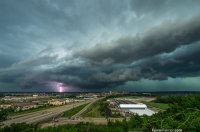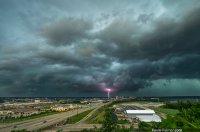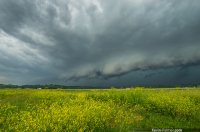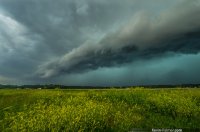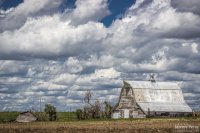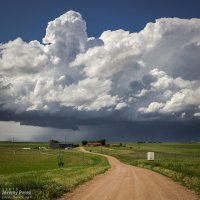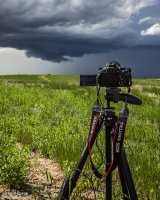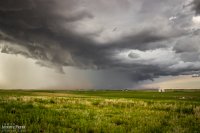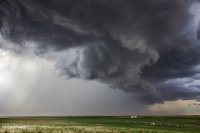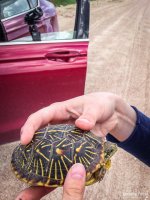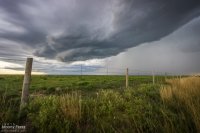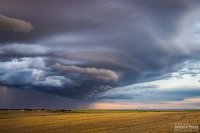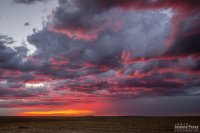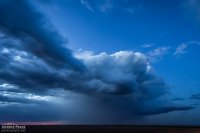Darren Lo
EF0
- Joined
- Feb 25, 2012
- Messages
- 39
I started off the afternoon in Oklahoma City following the conclusion of a tour with Tempest. I had a choice of two roughly equally distant target areas, the OK/TX panhandles and the cold front in north central/northeast Kansas. I could reach either by approximately 0Z. I chose to play the cold front, partly because I didn't want to get pulled far west away from possible Day 2 action and my trip back home to the East coast. Dew points on the cold side were in the upper 60's and 0-6 km shear was forecast to be decent, so I figured I might be able to get a tail end supercell.
Some models suggested that there might also be convection around Wichita, and around 2230Z, an MCD was issued noting deepening cumulus along a pre-frontal trough from ICT to MCI. I was driving by the largest patch of cumulus at the time and thought the area looked fairly stoutly capped, so I forged onward to Salina where a few isolated cells had just gone up along the cold front. As I approached, both went supercellular with low wall clouds clearly visible from I-135 (sorry, no photos of the eastern cell).
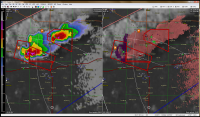
I targeted the tail-end cell on the west and was treated to some nice structure with a well-illuminated base.
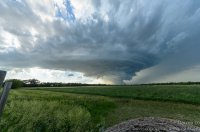
As time went on, the wall cloud almost seemed to be scraping the ground, but I noted that the updraft seemed to have become smaller and weaker, and that there was no flanking line. Although there was rotation in the wall cloud, I figured that no tornado was imminent, especially given the veered surface flow.
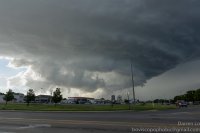
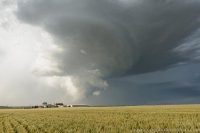
Having solo chased only a handful of times, I was perhaps overly cautious to stay away from the meso and the precip core. Unfortunately, this caused me to get behind the storm on Highway 4 at Elmo. With storm motion around 40 mph to the ESE, I decided not to try to race the storm to the next paved south option at Hope. Instead, I dropped south on 15, meaning my next paved east option was about 9 miles distant. Trying to take a dirt road to the east proved too slow and fruitless. So I followed behind the storm for a while, then said goodbye at dusk.
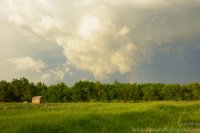
Some models suggested that there might also be convection around Wichita, and around 2230Z, an MCD was issued noting deepening cumulus along a pre-frontal trough from ICT to MCI. I was driving by the largest patch of cumulus at the time and thought the area looked fairly stoutly capped, so I forged onward to Salina where a few isolated cells had just gone up along the cold front. As I approached, both went supercellular with low wall clouds clearly visible from I-135 (sorry, no photos of the eastern cell).

I targeted the tail-end cell on the west and was treated to some nice structure with a well-illuminated base.

As time went on, the wall cloud almost seemed to be scraping the ground, but I noted that the updraft seemed to have become smaller and weaker, and that there was no flanking line. Although there was rotation in the wall cloud, I figured that no tornado was imminent, especially given the veered surface flow.


Having solo chased only a handful of times, I was perhaps overly cautious to stay away from the meso and the precip core. Unfortunately, this caused me to get behind the storm on Highway 4 at Elmo. With storm motion around 40 mph to the ESE, I decided not to try to race the storm to the next paved south option at Hope. Instead, I dropped south on 15, meaning my next paved east option was about 9 miles distant. Trying to take a dirt road to the east proved too slow and fruitless. So I followed behind the storm for a while, then said goodbye at dusk.


 P6074394
P6074394 IMG_0340[1]
IMG_0340[1] P6074438
P6074438